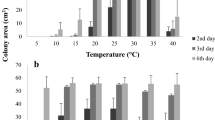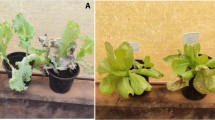Abstract
Pathogenicity and genetic variation were investigated within a collection of 104 banana-infecting isolates of Cylindrocladium (teleomorph Calonectria) originating from different countries and representing previously described morphological taxa or species. These root-rot fungi, along with endoparasitic nematodes, have been reported to be causal agents of necrotic lesions that induce root breakage and toppling of banana plants. Little is known about the individual pathogenic effects of the species involved or their genetic diversity. In the present study, among the five morphological taxa found in the banana rhizosphere, only isolates showing an atypical morphology relative to Cylindrocladium gracile (named Cy. gracile-like isolates) and Cy. spathiphylli isolates were pathogenic on banana cultivar Grande Naine. When comparing the latter isolates with others of the same species, but originating from different hosts, an analysis of rDNA spacer polymorphism partitioned isolates of Cy. spathiphylli by host into a banana – tea group and a Heliconia – Spathiphyllum group. Furthermore, isolates from Heliconia were not pathogenic on banana. A pathogenicity assessment of representative isolates from the Cy. gracile-like and the Cy. spathiphylli taxa on six different banana cultivars yielded no evidence of differential interactions between isolates and banana genotypes. Significant differences in susceptibility between banana genotypes were nevertheless detected that could potentially be exploited by breeders. Random amplified polymorphic DNA analysis revealed a genetic similarity ranging from 70% to 100% within Cy. spathiphylli isolates from bananas regardless of the geographic origin. Moreover, Cy. gracile-like isolates were highly similar but showed only 60% similarity relative to the Cy. gracile reference isolates, thus raising questions about their species status.
Similar content being viewed by others
References
Castaing V, Beveraggi A, Fouré E and Fogain R (1996) Detection of a Cylindrocladium sp. in Cameroon. Studies on pathogenic activity and interactions with R. similis. Infomusa 5: 4-7
Crous PW (2002) Taxonomy and Pathology of Cylindrocladium (Calonectria) and Allied Genera, APS Press, 294 p, St. Paul, Minnesota, USA
Crous PW and Peerally A (1996) Gliocladiopsis irregularis sp. nov. and notes on Cylindrocladium spathiphylli. Mycotaxon 65: 119-128
Crous PW and Wingfield MJ (1994) A monograph of Cylindrocladium including anamorphs of Calonectria. Mycotaxon 51: 341-435
Declerck S, Risede JM, Rufyikiri G and Delvaux B (2002) Effects of arbuscular mycorrhizal fungi on severity of root rot of bananas caused by Cy. spathiphylli. Plant Pathology 51: 109-115
Duchesne LC and Anderson JB (1990) Location and direction of transcription of the 5S rRNA in Armillaria. Mycological Research 94: 266-269
Felsenstein J (1995) PHYLIP (Phylogeny Inference Package) version 3.57c. Seattle: University of Washington, Department of Genetics, USA. Distributed by the author
Goodwin DC and Lee SB (1993) Microwave miniprep of total genomicDNAfrom fungi, plants, protists and animals for PCR. Biotechniques 15: 438-444
Gowen S and Queneherve P (1990) Nematode parasites of bananas, plantains and abaca. In: Luc et al. (eds) Plant Parasitic Nematodes in Subtropical and Tropical Agriculture (pp 431-460) CAB International, Wallingford, Oxon, UK
Jeng RS, Dumas M, Liu FH, Wang CL and Hubbes M(1997)DNA analysis of Cylindrocladium floridanum isolates from selected forest nurseries. Mycological Research 101: 285-291
Jenny C, Carreel F, Tomekpe K, Perrier X, Dubois C, Horry JP and Tezenas du Montcel H (1999) Les bananiers. In: Hamon et al. (eds) Diversité génétique des Plantes Cultivées (pp 113-139) Montpellier, France
Jones DR (1999) Diseases of Banana, Abaca and Enset, CAB International, Wallingford, Oxon, UK
Kang JC, Crous PW and Schoch CL (2001) Species concepts in the Cylindrocladium floridanum and Cy. spathiphylli complexes (Hypocreaceae) based on multi-allelic sequence data, sexual compatibility and morphology. Systematic and Applied Microbiology 24: 206-217
Kobenan K (1991) Parasites et ravageurs des bananiers en Côte d'Ivoire. Fruits 46: 633-641
Lassoudière A (1978) Quelques aspects de la croissance et du développement du bananier Poyo en Côte d'Ivoire. Le système radical. Fruits 33: 314-338
Loridat P (1989) Etude de la microflore fongique et des nématodes associés aux nécroses de l'appareil souterrain du bananier en Martinique. Mise en évidence du pouvoir pathogène du genre Cylindrocladium. Fruits 44: 587-597
Peerally A (1991) The classification and phytopathology of Cylindrocladium species. Mycotaxon 40: 323-366
Perrière G and Gouy M(1996)WWW-Query: An on-line retrieval system for biological sequence banks. Biochimie 78: 364-369
Price NS (1995) Banana morphology-Part I: Roots and rhizomes. In: Gowen Chapman et al. (eds) Bananas and Plantains (pp 179-189) London, UK
Risède JM (1994) Eléments de caractérisation de Cylindrocladium sp. agent de nécroses racinaires du bananier en Martinique. Fruits 49: 167-178
Risède JM (1995) Spatial and temporal distribution in soils of Cylindrocladium sp. fungal pathogen of bananas. Phytopathology 85: 1563
Risède JM and Simoneau P (2001) Typing Cylindrocladium species by analysis of ribosomal DNA spacers polymorphism: Application to field isolates from the banana rhizosphere. Mycologia 93: 494-504
Rossman AY (1979) Calonectria and its type species, C. daldiniana, a later synonym of C. pyrochroa. Mycotaxon 8: 321-328
Rossman AY (1983) The phragmosporous species of Nectria and related genera. Mycological Papers 150: 1-164
Schoch CL and Crous PW (1999) First report of Cylindrocladium root and petiole rot to Spathiphyllum in South Africa. South African Journal of Botany 65: 208-211
Schoch CL, Crous PW, Wingfield BD and Wingfield MJ (2001) Phylogeny of Calonectria based on comparisons of β-tubulin DNA sequences. Mycological Research 105: 1045-1052
Schoulties CL, El-Gholl NE and Alfieri SA (1982) Cy. spathiphylli sp. nov. Mycotaxon 16: 265-272
Semer CR, Mitchell DJ, Mitchell ME, Martin FR and Alfenas AC (1987) Isolation, identification and chemical control of Cylindrocladium musae sp. nov. associated with toppling disease of banana. Phytopathology 77: 1729
Sokal RRR and Michener CD (1958) A statistical method for evaluation of systematic relationships. University of Kansas Science Bulletin 38: 1409-1438
Stover RH and Simmonds NW (1987) Bananas, 3rd edn. 468 p, Longman Scientific & Technical, Harlow, UK
Thies WG and Patton RF (1970) Biology of Cylindrocladium scoparium in Wisconsin forest tree nurseries. Phytopathology 60: 1662-1668
Thompson JD, Higgins DG and Gibson TJ (1994) CLUSTALW: Improving the sensitivity of progressive multiple sequence alignment through sequence weighting, position-specific gap penalties and weight matrix choice. Nucleic Acids Research 22: 4673-4680
Uchida JY (1989) Cylindrocladium rot of Spathiphyllum. Hawaii Institute of Tropical Agriculture and Human Resources Brief 78: 1-4
Uchida JY and Aragaki M (1992) Further characterization of Cy. spathiphylli from Spathiphyllum in Hawaii and Florida. Mycologia 84: 810-814
Uchida JY, Aragaki M and Yahata PS (1989). Heliconia root rot and foliar blight caused by Cylindrocladium. Hawaii Institute of Tropical Agriculture and Human Resources Brief 85: 1-2
White TJ, Bruns T, Lee S and Taylor J (1990) Amplification and direct sequencing of fungal ribosomal genes for phylogenetics. In: Innis MA, Gelfand DH, Sninsky JJ and White TJ (eds) PCR Protocols: A Guide to Methods and Applications (pp 315-322) Academic Press, San Diego
Author information
Authors and Affiliations
Rights and permissions
About this article
Cite this article
Risède, JM., Simoneau, P. Pathogenic and Genetic Diversity of Soilborne Isolates of Cylindrocladium from Banana Cropping Systems. European Journal of Plant Pathology 110, 139–154 (2004). https://doi.org/10.1023/B:EJPP.0000015337.54178.c0
Issue Date:
DOI: https://doi.org/10.1023/B:EJPP.0000015337.54178.c0




